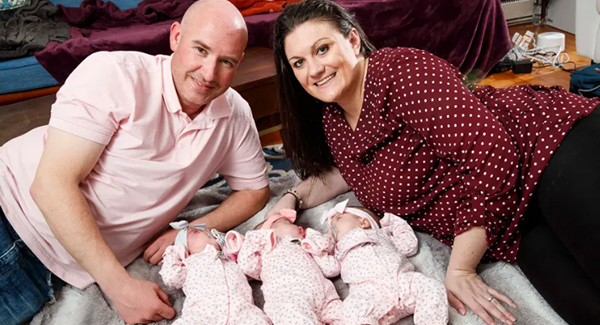Meet the Getting triplets — the adorable trio of identical sisters who, according to experts, were born at odds ranging from 1 in 1 million to 1 in 200 million.
“They are true miracles,” New York City school teacher Lauren, 34, told The Post in between round-the-clock diaper changes and feedings.
The babies, conceived naturally and consequently known as “spontaneous,” resulted from Lauren’s one fertilized egg splitting into three, causing the embryos to share the same placenta.
She found out about the unusual incident during her six-week checkup in March and texted Andrew, whom she had married only four months before.
“I was driving and Siri translated the message for me,” said Andrew. Fortunately, he didn’t crash the car when he heard there were three fetuses in total. Still, the surprised dad thought Lauren was joking at first. As a result, Siri parlayed his immediate response: “Bulls–t!”
“But I soon realized Lauren was telling the truth,” added the 40-year-old, who lost his salesman job due to the pandemic and is currently seeking employment.
Lauren enlisted the help of specialist Dr. Victor Klein because her triple pregnancy was considered high-risk. The renowned OB-GYN is based a half-hour drive from the couple’s Lido Beach, LI, villa. He is vice chair of obstetrics and gynecology at North Shore University Hospital.
Klein said reports in medical literature of the chances of identical triplets range from 1 in a million to 1 in 200 million. “We can’t pin it down exactly because the statistics are uncertain,” he said. “But it is incredibly exciting when it happens.”
Lauren, a biology teacher at John Bowne Elevated School in Flushing, experienced severe morning sickness — “the hormones were treble,” she said — as well as heartburn, acid reflux, and high blood pressure during her pregnancy.
“At the end of my first trimester, I was already as big as most women are in their third,” she said. “It was the hardest physical thing I have ever done in my life.”
Mercifully, her discomfort ended when Klein performed a C-section near the milestone of 32 weeks. Charlotte was delivered first, weighing 3 pounds, 15 ounces, then Emma arrived, at 4 pounds, 7 ounces, followed by 4-pound, 4-ounce Cora.
The neonates were rushed to the NICU because they needed help breathing. They were in the hospital for more than seven weeks before being released on successive days.
Since then, the Gettings’ domestic life has been hectic. “My mom always said: ‘God only gives you what you can handle,’” said Lauren, before quipping, “And my answer is: ’I just wish he wouldn’t trust me so much!’”
The new parents took turns feeding and changing the girls in 12-hour shifts, and have quickly picked up on their individual personalities.
“Charlotte is the spunky one, Cora is more laid-back, while Emma is very resilient,” said Andrew, who has three kids — including twins — from a previous relationship.
To tell the look-alikes apart, each one has a different color of child-safe nail polish on her toes.
“Cora is peach, Charlotte is green and Emma is purple,” explained Lauren.
The couple has been battling to keep up with the high costs of caring for three newborns, which include special formula for preterm babies and all of the necessary baby gear. In a year, they will require approximately 10,000 diapers.







